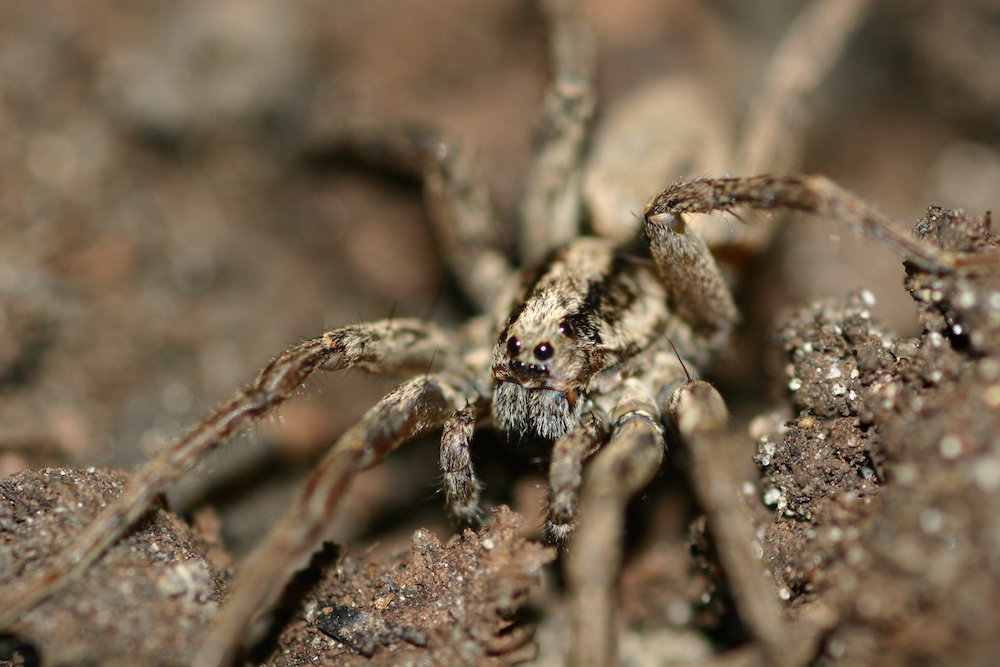'Purring' Wolf Spiders Softly Serenade Mates

Male wolf spiders use "purring" vibrations to serenade their sweethearts, but this wooing only works if the females can feel these vibrations, new research finds.
For the females to feel these vibrations, the courting couple must be standing on a suitable surface that can vibrate, like dry leaves, the researchers said in the new study.
Scientists had known that wolf spiders could make airborne sounds that are audible to humans. But this group of spiders doesn't have typical ears, and it's assumed that the critters can't actually hear any airborne sounds, said Alexander Sweger, a doctoral student of biology at the University of Cincinnati, who presented the unpublished research at the Acoustical Society of America's annual meeting in Pittsburgh on May 21. [Watch Wolf Spiders Make "Purring" Vibrations (Video)]
"They're quiet — nothing on the order of crickets," Sweger told Live Science. "We think this airborne sound is primarily a byproduct. As far as we can tell, they may not deliberately be producing a sound."
In fact, the "purring" wolf spider (Gladicosa gulosa) may help researchers learn how some animals use vibration, but not sound, to communicate, he said. Moreover, it's possible that acoustic communication evolved from vibration, which is linked with sound, he said.
Sweger and his adviser, George Uetz, a professor of biological sciences at the University of Cincinnati, came across Gladicosa gulosa in the field one day. Intrigued, Sweger began reading literature on the species but found little research beyond the observational and anecdotal. So, he decided to study the spider, which has the unique ability to produce both vibrations and acoustic noises during courtship, he said.
The organ resembles a musical instrument: The wolf spider has two small, leglike appendages near its mouth called pedipalps. The lowest joint on the pedipalp has a rough surface (called a file) on one side and a scraper on the other. The spider can rub its pedipalps together so that the file and scraper cross each other, "and that creates the vibrations that then travel down the limb to the leaf," Sweger said. Wolf spiders don't spin webs, but are adept hunters with keen eyesight. Researchers have known about wolf spider vibrations since the 1970s, when they described their stridulatory organ, Sweger said.
Get the world’s most fascinating discoveries delivered straight to your inbox.
"They're courting on dead leaves," he said. "And that leaf itself is what's resulting in the airborne sound."
Good vibrations
In an experiment, Sweger and his colleagues recorded the vibration made by a male G. gulosa with an instrument that can digitize the vibration and convert it into an audible sound. They also used a microphone to record the spider during courtship, "so it's essentially the airborne sound you would hear in the room," he said.
Then, they played the airborne sounds to both males and females that were stationed on either granite or paper.
"What we found is that males never really showed a response, but females did when they were on paper," Sweger said.
Normally, the females were still, but when they felt the vibrations on the paper, they began moving around, he said. The paper, much like a dead leaf, likely picks up the vibrations from the male suitor, Sweger said.
The spiders' sensitivity to vibrations may also help them avoid predators. "We've shown in another species that they'll respond to bird calls if on a substrate [such as a leaf or paper]," he said.
Follow Laura Geggel on Twitter @LauraGeggel. Follow Live Science @livescience, Facebook & Google+. Original article on Live Science.

Laura is the managing editor at Live Science. She also runs the archaeology section and the Life's Little Mysteries series. Her work has appeared in The New York Times, Scholastic, Popular Science and Spectrum, a site on autism research. She has won multiple awards from the Society of Professional Journalists and the Washington Newspaper Publishers Association for her reporting at a weekly newspaper near Seattle. Laura holds a bachelor's degree in English literature and psychology from Washington University in St. Louis and a master's degree in science writing from NYU.


